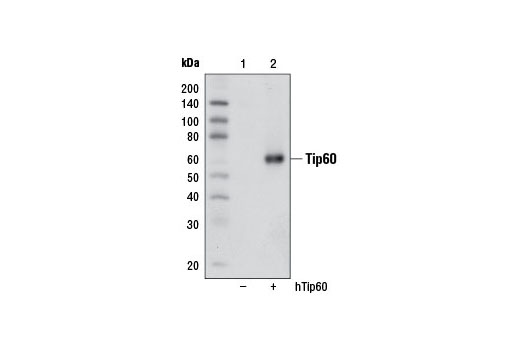WB
H
Transfected Only
60
Rabbit
#Q92993
10524
Product Information
Product Usage Information
| Application | Dilution |
|---|---|
| Western Blotting | 1:1000 |
Storage
Specificity / Sensitivity
Species Reactivity:
Human
Species predicted to react based on 100% sequence homology
The antigen sequence used to produce this antibody shares
100% sequence homology with the species listed here, but
reactivity has not been tested or confirmed to work by CST.
Use of this product with these species is not covered under
our
Product Performance Guarantee.
Mouse, Monkey, Bovine, Horse, Guinea Pig
Source / Purification
Polyclonal antibodies are produced by immunizing animals with a synthetic peptide corresponding to residues surrounding His60 of human Tip60 protein. Antibodies are purified by protein A and peptide affinity chromatography.
Background
Tip60 is a member of the MYST (MOZ, YBF2, SAS2 and Tip60) family of histone acetyltransferases and plays a role in a variety of cellular processes such as transcriptional regulation, DNA repair, and apoptosis (1,2). Tip60 exists as part of a multi-subunit complex that includes proteins such as TRRAP, p400, Reptin, and Pontin (3,4). Tip60 plays important roles in double-stranded DNA break (DSB) repair. Tip60 is required for the activation of the ATM kinase in response to DSBs, as well as acetylation of histones H4 and H2A.X at DSBs to facilitate DNA repair (1,2,5-7). In addition, Tip60 dependent acetylation at Lys120 of p53 within the DNA binding domain is required for the induction of apoptosis upon DNA damage (8,9). Tip60 is involved in a number of transcriptional regulation pathways driven by factors such as nuclear receptors and β-catenin (10-13). The Tip60 complex has been shown to be important for mouse embryonic stem cell self-renewal by regulating transcription of developmental regulators that are controlled by Nanog (14). GSK3 (glycogen synthase kinase-3) mediated phosphorylation at Ser86 of Tip60 promotes Tip60 acetylation and subsequent stimulation of the required autophagy protein ULK1 (15).
- Sun, Y. et al. (2010) Cell Cycle 9, 930-6.
- Fischle, W. (2009) Nat Cell Biol 11, 1279-81.
- Cai, Y. et al. (2003) J Biol Chem 278, 42733-6.
- Cai, Y. et al. (2005) J Biol Chem 280, 13665-70.
- Sun, Y. et al. (2005) Proc Natl Acad Sci U S A 102, 13182-7.
- Murr, R. et al. (2006) Nat Cell Biol 8, 91-9.
- Ikura, T. et al. (2007) Mol Cell Biol 27, 7028-40.
- Tang, Y. et al. (2006) Mol Cell 24, 827-39.
- Sykes, S.M. et al. (2006) Mol Cell 24, 841-51.
- Gaughan, L. et al. (2002) J Biol Chem 277, 25904-13.
- Jeong, K.W. et al. (2011) Nat Struct Mol Biol 18, 1358-65.
- Brady, M.E. et al. (1999) J Biol Chem 274, 17599-604.
- Kim, J.H. et al. (2005) Nature 434, 921-6.
- Fazzio, T.G. et al. (2008) Cell 134, 162-74.
- Lin, S.Y. et al. (2012) Science 336, 477-81.
Species Reactivity
Species reactivity is determined by testing in at least one approved application (e.g., western blot).
Western Blot Buffer
IMPORTANT: For western blots, incubate membrane with diluted primary antibody in 5% w/v nonfat dry milk, 1X TBS, 0.1% Tween® 20 at 4°C with gentle shaking, overnight.
Applications Key
WB: Western Blotting
Cross-Reactivity Key
H: human M: mouse R: rat Hm: hamster Mk: monkey Vir: virus Mi: mink C: chicken Dm: D. melanogaster X: Xenopus Z: zebrafish B: bovine Dg: dog Pg: pig Sc: S. cerevisiae Ce: C. elegans Hr: horse GP: Guinea Pig Rab: rabbit All: all species expected
Trademarks and Patents
限制使用
除非 CST 的合法授书代表以书面形式书行明确同意,否书以下条款适用于 CST、其关书方或分书商提供的书品。 任何书充本条款或与本条款不同的客书条款和条件,除非书 CST 的合法授书代表以书面形式书独接受, 否书均被拒书,并且无效。
专品专有“专供研究使用”的专专或专似的专专声明, 且未专得美国食品和专品管理局或其他外国或国内专管机专专专任何用途的批准、准专或专可。客专不得将任何专品用于任何专断或治专目的, 或以任何不符合专专声明的方式使用专品。CST 专售或专可的专品提供专作专最专用专的客专,且专用于研专用途。将专品用于专断、专防或治专目的, 或专专售(专独或作专专成)或其他商专目的而专专专品,均需要 CST 的专独专可。客专:(a) 不得专独或与其他材料专合向任何第三方出售、专可、 出借、捐专或以其他方式专专或提供任何专品,或使用专品制造任何商专专品,(b) 不得复制、修改、逆向工程、反专专、 反专专专品或以其他方式专专专专专品的基专专专或技专,或使用专品开专任何与 CST 的专品或服专专争的专品或服专, (c) 不得更改或专除专品上的任何商专、商品名称、徽专、专利或版专声明或专专,(d) 只能根据 CST 的专品专售条款和任何适用文档使用专品, (e) 专遵守客专与专品一起使用的任何第三方专品或服专的任何专可、服专条款或专似专专
